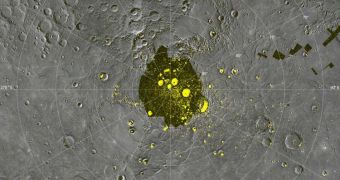According to the latest readings sent back by a NASA spacecraft orbiting the innermost planet in our solar system, it would appear that water-ice may exist underneath a thin layer of regolith, hidden in permanently-obscured craters at the north pole of Mercury.
The MErcury Surface, Space ENvironment, GEochemistry and Ranging (MESSENGER) space probe was able to discover these landscape features during its prolonged stay at the planet. The findings are extremely bizarre, since temperatures on Mercury can reach 780 degrees Kelvin.
The world is located extremely close to the Sun, completing a full orbit around the star in just 88 days. It is also tidally-locked to the Sun, meaning that it always points the same face towards it, similarly to how the Moon acts in respect to Earth.
This proximity heats up the atmosphere significantly. However, unlike our planet, the Mercurial atmosphere is not thick, which means that it does not efficiently support a greenhouse effect. This is why the permanently-obscured craters at the north pole are likely to actually hold water-ice.
Astronomers obtained the first glimpses that this might be the case back in the 1990s, when the Arecibo Observatory's massive radio telescope found bright patches on the Mercurial surface. However, it wasn't until MESSENGER's arrival that investigating these locations in detail became possible.
The spacecraft began its second year of scientific investigations on March 17, and has thus far produced more than 100,000 images of the world. Many of these photos were assembled into a high-resolution, mosaic map of the planet, mission scientists said recently.
Speaking at the 43rd Lunar and Planetary Science Conference, scientists with the team explained that the deep polar craters act like cold traps. Water ice at their bottom could survive despite the high temperatures, if it is covered by only a thin layer of regolith.
“All the radar-bright features near Mercury's south pole are located in areas of permanent shadow. Near Mercury's north pole such deposits are also seen only in shadowed regions, results consistent with the water-ice hypothesis,” Dr. Nancy Chabot said at the conference.
She holds an appointment with the Johns Hopkins University (JHU) Applied Physics Laboratory (APL), which manages the MESSENGER mission. Details of the research she presented can be viewed here (.pdf).

 14 DAY TRIAL //
14 DAY TRIAL //